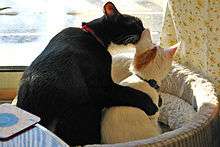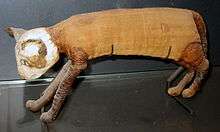Cat
The cat (Felis catus) is a domestic species of small carnivorous mammal.[1][2] It is the only domesticated species in the family Felidae and is often referred to as the domestic cat to distinguish it from the wild members of the family.[4] A cat can either be a house cat, a farm cat or a feral cat; the latter ranges freely and avoids human contact.[5] Domestic cats are valued by humans for companionship and their ability to hunt rodents. About 60 cat breeds are recognized by various cat registries.[6]
| Domestic cat | |
|---|---|
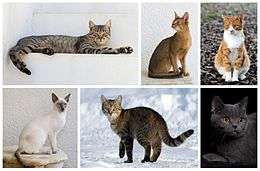 | |
| Various types of the domestic cat | |
Domesticated | |
| Scientific classification | |
| Kingdom: | Animalia |
| Phylum: | Chordata |
| Class: | Mammalia |
| Order: | Carnivora |
| Suborder: | Feliformia |
| Family: | Felidae |
| Subfamily: | Felinae |
| Genus: | Felis |
| Species: | F. catus[1] |
| Binomial name | |
| Felis catus[1] | |
| Synonyms | |
The cat is similar in anatomy to the other felid species: it has a strong flexible body, quick reflexes, sharp teeth and retractable claws adapted to killing small prey. Its night vision and sense of smell are well developed. Cat communication includes vocalizations like meowing, purring, trilling, hissing, growling and grunting as well as cat-specific body language. It is a solitary hunter but a social species. It can hear sounds too faint or too high in frequency for human ears, such as those made by mice and other small mammals. It is a predator that is most active at dawn and dusk.[7] It secretes and perceives pheromones.[8]
Female domestic cats can have kittens from spring to late autumn, with litter sizes often ranging from two to five kittens.[9] Domestic cats are bred and shown at events as registered pedigreed cats, a hobby known as cat fancy. Failure to control breeding of pet cats by spaying and neutering, as well as abandonment of pets, resulted in large numbers of feral cats worldwide, contributing to the extinction of entire bird, mammal, and reptile species, and evoking population control.[10]
Cats were first domesticated in the Near East around 7500 BC.[11] It was long thought that cat domestication was initiated in Ancient Egypt, as since around 3100 BC veneration was given to cats in ancient Egypt.[12][13]
As of 2017, the domestic cat was the second-most popular pet in the United States by number of pets owned, after freshwater fish,[14] with 95 million cats owned.[15][16] In the United Kingdom, around 7.3 million cats lived in more than 4.8 million households as of 2019.[17]
Etymology and naming
The origin of the English word 'cat', Old English catt, is thought to be the Late Latin word cattus, which was first used at the beginning of the 6th century.[18] It was suggested that the word 'cattus' is derived from an Egyptian precursor of Coptic ϣⲁⲩ šau, "tomcat", or its feminine form suffixed with -t.[19] The Late Latin word is also thought to be derived from Afro-Asiatic languages.[20] The Nubian word kaddîska "wildcat" and Nobiin kadīs are possible sources or cognates.[21] The Nubian word may be a loan from Arabic قَطّ qaṭṭ ~ قِطّ qiṭṭ. It is "equally likely that the forms might derive from an ancient Germanic word, imported into Latin and thence to Greek and to Syriac and Arabic".[22] The word may be derived from Germanic and Northern European languages, and ultimately be borrowed from Uralic, cf. Northern Sami gáđfi, "female stoat", and Hungarian hölgy, "stoat"; from Proto-Uralic *käďwä, "female (of a furred animal)".[23]
The English puss, extended as pussy and pussycat, is attested from the 16th century and may have been introduced from Dutch poes or from Low German puuskatte, related to Swedish kattepus, or Norwegian pus, pusekatt. Similar forms exist in Lithuanian puižė and Irish puisín or puiscín. The etymology of this word is unknown, but it may have simply arisen from a sound used to attract a cat.[24][25]
A male cat is called a tom or tomcat[26] (or a gib,[27] if neutered) An unspayed female is called a queen,[28] especially in a cat-breeding context. A juvenile cat is referred to as a kitten. In Early Modern English, the word kitten was interchangeable with the now-obsolete word catling.[29] A group of cats can be referred to as a clowder or a glaring.[30]
Taxonomy
The scientific name Felis catus was proposed by Carl Linnaeus in 1758 for a domestic cat.[1][2] Felis catus domesticus was proposed by Johann Christian Polycarp Erxleben in 1777.[3] Felis daemon proposed by Konstantin Alekseevich Satunin in 1904 was a black cat from the Transcaucasus, later identified as a domestic cat.[31][32]
In 2003, the International Commission on Zoological Nomenclature ruled that the domestic cat is a distinct species, namely Felis catus.[33][34] In 2007, it was considered a subspecies of the European wildcat, F. silvestris catus, following results of phylogenetic research.[35][36] In 2017, the IUCN Cat Classification Taskforce followed the recommendation of the ICZN in regarding the domestic cat as a distinct species, Felis catus.[37]
Evolution
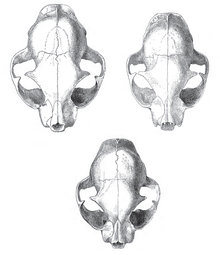
The domestic cat is a member of the Felidae, a family that had a common ancestor about 10–15 million years ago.[38] The genus Felis diverged from the Felidae around 6–7 million years ago.[39] Results of phylogenetic research confirm that the wild Felis species evolved through sympatric or parapatric speciation, whereas the domestic cat evolved through artificial selection.[40] The domesticated cat and its closest wild ancestor are both diploid organisms that possess 38 chromosomes[41] and roughly 20,000 genes.[42] The leopard cat (Prionailurus bengalensis) was tamed independently in China around 5500 BCE. This line of partially domesticated cats leaves no trace in the domestic cat populations of today.[43]
Domestication
.jpg)
The earliest known indication for the taming of an African wildcat (F. lybica) was excavated close by a human Neolithic grave in Shillourokambos, southern Cyprus, dating to about 9,200 to 9,500 years before present. Since there is no evidence of native mammalian fauna on Cyprus, the inhabitants of this Neolithic village most likely brought the cat and other wild mammals to the island from the Middle Eastern mainland.[44] Scientists therefore assume that African wildcats were attracted to early human settlements in the Fertile Crescent by rodents, in particular the house mouse (Mus musculus), and were tamed by Neolithic farmers. This commensal relationship between early farmers and tamed cats lasted thousands of years. As agricultural practices spread, so did tame and domesticated cats.[11][6] Wildcats of Egypt contributed to the maternal gene pool of the domestic cat at a later time.[45] The earliest known evidence for the occurrence of the domestic cat in Greece dates to around 1200 BCE. Greek, Phoenician, Carthaginian and Etruscan traders introduced domestic cats to southern Europe.[46] During the Roman Empire they were introduced to Corsica and Sardinia before the beginning of the 1st millennium.[47] By the 5th century BCE, they were familiar animals around settlements in Magna Graecia and Etruria.[48] By the end of the Roman Empire in the 5th century, the Egyptian domestic cat lineage had arrived in a Baltic Sea port in northern Germany.[45]
During domestication, cats have undergone only minor changes in anatomy and behavior, and they are still capable of surviving in the wild. Several natural behaviors and characteristics of wildcats may have pre-adapted them for domestication as pets. These traits include their small size, social nature, obvious body language, love of play and relatively high intelligence. Captive Leopardus cats may also display affectionate behavior toward humans, but were not domesticated.[49] House cats often mate with feral cats,[50] producing hybrids such as the Kellas cat in Scotland.[51] Hybridisation between domestic and other Felinae species is also possible.[52]
Development of cat breeds started in the mid 19th century.[53] An analysis of the domestic cat genome revealed that the ancestral wildcat genome was significantly altered in the process of domestication, as specific mutations were selected to develop cat breeds.[54] Most breeds are founded on random-bred domestic cats. Genetic diversity of these breeds varies between regions, and is lowest in purebred populations, which show more than 20 deleterious genetic disorders.[55]
Characteristics
Size

The domestic cat has a smaller skull and shorter bones than the European wildcat.[56] It averages about 46 cm (18 in) in head-to-body length and 23–25 cm (9–10 in) in height, with about 30 cm (12 in) long tails. Males are larger than females.[57] Adult domestic cats typically weigh between 4 and 5 kg (9 and 11 lb).[40]
Skeleton
Cats have seven cervical vertebrae (as do most mammals); 13 thoracic vertebrae (humans have 12); seven lumbar vertebrae (humans have five); three sacral vertebrae (as do most mammals, but humans have five); and a variable number of caudal vertebrae in the tail (humans have only vestigial caudal vertebrae, fused into an internal coccyx).[58]:11 The extra lumbar and thoracic vertebrae account for the cat's spinal mobility and flexibility. Attached to the spine are 13 ribs, the shoulder, and the pelvis.[58]:16 Unlike human arms, cat forelimbs are attached to the shoulder by free-floating clavicle bones which allow them to pass their body through any space into which they can fit their head.[59]
Skull
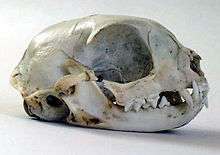
The cat skull is unusual among mammals in having very large eye sockets and a powerful specialized jaw.[60]:35 Within the jaw, cats have teeth adapted for killing prey and tearing meat. When it overpowers its prey, a cat delivers a lethal neck bite with its two long canine teeth, inserting them between two of the prey's vertebrae and severing its spinal cord, causing irreversible paralysis and death.[61] Compared to other felines, domestic cats have narrowly spaced canine teeth relative to the size of their jaw, which is an adaptation to their preferred prey of small rodents, which have small vertebrae.[61] The premolar and first molar together compose the carnassial pair on each side of the mouth, which efficiently shears meat into small pieces, like a pair of scissors. These are vital in feeding, since cats' small molars cannot chew food effectively, and cats are largely incapable of mastication.[60]:37 Although cats tend to have better teeth than most humans, with decay generally less likely because of a thicker protective layer of enamel, a less damaging saliva, less retention of food particles between teeth, and a diet mostly devoid of sugar, they are nonetheless subject to occasional tooth loss and infection.[62]
Ambulation
The cat is digitigrade. It walks on the toes, with the bones of the feet making up the lower part of the visible leg.[63] Unlike most mammals, it uses a "pacing" gait and moves both legs on one side of the body before the legs on the other side. It registers directly by placing each hind paw close to the track of the corresponding fore paw, minimizing noise and visible tracks. This also provides sure footing for hind paws when navigating rough terrain. As it speeds up walking to trotting, its gait changes to a "diagonal" gait: The diagonally opposite hind and fore legs move simultaneously.[64]
Claws
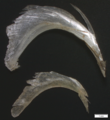
Cats have protractable and retractable claws.[65] In their normal, relaxed position, the claws are sheathed with the skin and fur around the paw's toe pads. This keeps the claws sharp by preventing wear from contact with the ground and allows the silent stalking of prey. The claws on the fore feet are typically sharper than those on the hind feet.[66] Cats can voluntarily extend their claws on one or more paws. They may extend their claws in hunting or self-defense, climbing, kneading, or for extra traction on soft surfaces. Cats shed the outside layer of their claw sheaths when scratching rough surfaces.[67]
Most cats have five claws on their front paws, and four on their rear paws. The dewclaw is proximal to the other claws. More proximally is a protrusion which appears to be a sixth "finger". This special feature of the front paws, on the inside of the wrists has no function in normal walking, but is thought to be an antiskidding device used while jumping. Some cat breeds are prone to having extra digits (“polydactyly”).[68] Polydactylous cats occur along North America's northeast coast and in Great Britain.[69]
Senses
Vision
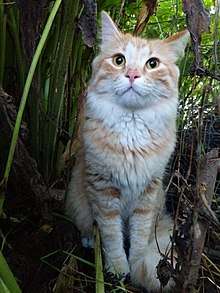
Cats have excellent night vision and can see at only one-sixth the light level required for human vision.[60]:43 This is partly the result of cat eyes having a tapetum lucidum, which reflects any light that passes through the retina back into the eye, thereby increasing the eye's sensitivity to dim light.[70] Large pupils are an adaptation to dim light. The domestic cat has slit pupils, which allow it to focus bright light without chromatic aberration.[71] At low light, a cat's pupils expand to cover most of the exposed surface of its eyes.[72] However, the domestic cat has rather poor color vision and only two types of cone cells, optimized for sensitivity to blue and yellowish green; its ability to distinguish between red and green is limited.[73] A response to middle wavelengths from a system other than the rod cells might be due to a third type of cone. However, this appears to be an adaptation to low light levels rather than representing true trichromatic vision.[74]
Hearing
The domestic cat's hearing is most acute in the range of 500 Hz to 32 kHz.[75] It can detect an extremely broad range of frequencies ranging from 55 Hz to 79,000 Hz. It can hear a range of 10.5 octaves, while humans and dogs can hear ranges of about 9 octaves.[76][77] Its hearing sensitivity is enhanced by its large movable outer ears, the pinnae, which amplify sounds and help detect the location of a noise. It can detect ultrasound, which enables it to detect ultrasonic calls made by rodent prey.[78][79]
Smell
Cats have an acute sense of smell, due in part to their well-developed olfactory bulb and a large surface of olfactory mucosa, about 5.8 square centimetres (29⁄32 square inch) in area, which is about twice that of humans.[80] Cats and many other animals have a Jacobson's organ in their mouths that is used in the behavioral process of flehmening. It allows them to sense certain aromas in a way that humans cannot. Cats are sensitive to pheromones such as 3-mercapto-3-methylbutan-1-ol,[81] which they use to communicate through urine spraying and marking with scent glands.[82] Many cats also respond strongly to plants that contain nepetalactone, especially catnip, as they can detect that substance at less than one part per billion.[83] About 70–80% of cats are affected by nepetalactone.[84] This response is also produced by other plants, such as silver vine (Actinidia polygama) and the herb valerian; it may be caused by the smell of these plants mimicking a pheromone and stimulating cats' social or sexual behaviors.[85]
Taste
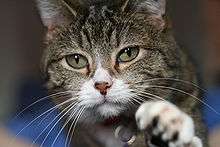
Cats have relatively few taste buds compared to humans (470 or so versus more than 9,000 on the human tongue).[86] Domestic and wild cats share a taste receptor gene mutation that keeps their sweet taste buds from binding to sugary molecules, leaving them with no ability to taste sweetness.[87] Their taste buds instead respond to acids, amino acids like protein, and bitter tastes.[88] Cats also have a distinct temperature preference for their food, preferring food with a temperature around 38 °C (100 °F) which is similar to that of a fresh kill and routinely rejecting food presented cold or refrigerated (which would signal to the cat that the "prey" item is long dead and therefore possibly toxic or decomposing).[86]
Whiskers
To aid with navigation and sensation, cats have dozens of movable whiskers (vibrissae) over their body, especially their faces. These provide information on the width of gaps and on the location of objects in the dark, both by touching objects directly and by sensing air currents; they also trigger protective blink reflexes to protect the eyes from damage.[60]:47
Balance
Most breeds of cat have a noted fondness for sitting in high places, or perching. A higher place may serve as a concealed site from which to hunt; domestic cats strike prey by pouncing from a perch such as a tree branch. Another possible explanation is that height gives the cat a better observation point, allowing it to survey its territory. A cat falling from heights of up to 3 meters can right itself and land on its paws.[89] During a fall from a high place, a cat reflexively twists its body and rights itself to land on its feet using its acute sense of balance and flexibility. This reflex is known as the cat righting reflex.[90] An individual cat always rights itself in the same way during a fall, provided it has sufficient time to do so. The height required for this to occur is around 90 cm (2 ft 11 in).[91] Several explanations have been proposed for this phenomenon since the late 19th century:
- Cats rely on conservation of angular momentum.[92]
- The rotation angle of the front body is larger than that of the rear body.[93]
- The dynamics of the falling cat have been explained using the Udwadia–Kalaba equation.[94]
Behavior
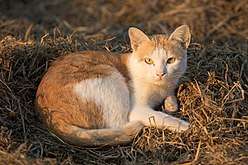
Outdoor cats are active both day and night, although they tend to be slightly more active at night.[95] Domestic cats spend the majority of their time in the vicinity of their homes, but can range many hundreds of meters from this central point. They establish territories that vary considerably in size, in one study ranging from 7 to 28 hectares (17–69 acres).[96] The timing of cats' activity is quite flexible and varied, which means house cats may be more active in the morning and evening, as a response to greater human activity at these times.[97]
Cats conserve energy by sleeping more than most animals, especially as they grow older. The daily duration of sleep varies, usually between 12 and 16 hours, with 13 and 14 being the average. Some cats can sleep as much as 20 hours. The term "cat nap" for a short rest refers to the cat's tendency to fall asleep (lightly) for a brief period. While asleep, cats experience short periods of rapid eye movement sleep often accompanied by muscle twitches, which suggests they are dreaming.[98]
Sociability
The social behavior of the domestic cat ranges from widely dispersed individuals to feral cat colonies that gather around a food source, based on groups of co-operating females.[99][100] Within such groups, one cat is usually dominant over the others.[101] Each cat in a colony holds a distinct territory, with sexually active males having the largest territories, which are about 10 times larger than those of female cats and may overlap with several females' territories. These territories are marked by urine spraying, by rubbing objects at head height with secretions from facial glands, and by defecation.[82] Between these territories are neutral areas where cats watch and greet one another without territorial conflicts. Outside these neutral areas, territory holders usually chase away stranger cats, at first by staring, hissing, and growling and, if that does not work, by short but noisy and violent attacks. Despite some cats cohabiting in colonies, they do not have a social survival strategy, or a pack mentality and always hunt alone.[102]
However, some pet cats are poorly socialized. In particular, older cats show aggressiveness towards newly arrived kittens, which include biting and scratching; this type of behavior is known as feline asocial aggression.[103]
Life in proximity to humans and other domestic animals has led to a symbiotic social adaptation in cats, and cats may express great affection toward humans or other animals. Ethologically, the human keeper of a cat functions as a sort of surrogate for the cat's mother.[104] Adult cats live their lives in a kind of extended kittenhood, a form of behavioral neoteny. Their high-pitched sounds may mimic the cries of a hungry human infant, making them particularly difficult for humans to ignore.[105]
Domestic cats' scent rubbing behavior towards humans or other cats is thought to be a feline means for social bonding.[106]
Communication
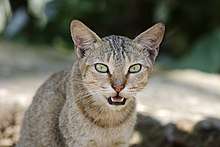
Domestic cats use many vocalizations for communication, including purring, trilling, hissing, growling/snarling, grunting, and several different forms of meowing.[7] Their body language, including position of ears and tail, relaxation of the whole body, and kneading of the paws, are all indicators of mood. The tail and ears are particularly important social signal mechanisms in cats. A raised tail indicates a friendly greeting, and flattened ears indicates hostility. Tail-raising also indicates the cat's position in the group's social hierarchy, with dominant individuals raising their tails less often than subordinate ones.[107] Feral cats are generally silent.[108]:208 Nose-to-nose touching is also a common greeting and may be followed by social grooming, which is solicited by one of the cats raising and tilting its head.[100]
Purring may have developed as an evolutionary advantage as a signalling mechanism of reassurance between mother cats and nursing kittens. Post-nursing cats often purr as a sign of contentment: when being petted, becoming relaxed,[109][110] or eating. The mechanism by which cats purr is elusive. The cat has no unique anatomical feature that is clearly responsible for the sound.[111]
Grooming
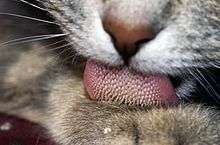
Cats are known for spending considerable amounts of time licking their coats to keep them clean.[112] The cat's tongue has backwards-facing spines about 500 μm long, which are called papillae. These contain keratin which makes them rigid[113] so the papillae act like a hairbrush. Some cats, particularly longhaired cats, occasionally regurgitate hairballs of fur that have collected in their stomachs from grooming. These clumps of fur are usually sausage-shaped and about 2–3 cm (3⁄4–1 1⁄4 in) long. Hairballs can be prevented with remedies that ease elimination of the hair through the gut, as well as regular grooming of the coat with a comb or stiff brush.[112]
Fighting
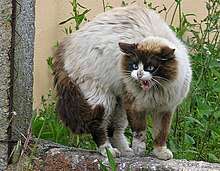
Among domestic cats, males are more likely to fight than females.[114] Among feral cats, the most common reason for cat fighting is competition between two males to mate with a female. In such cases, most fights are won by the heavier male.[115] Another common reason for fighting in domestic cats is the difficulty of establishing territories within a small home.[114] Female cats also fight over territory or to defend their kittens. Neutering will decrease or eliminate this behavior in many cases, suggesting that the behavior is linked to sex hormones.[116]
When cats become aggressive, they try to make themselves appear larger and more threatening by raising their fur, arching their backs, turning sideways and hissing or spitting.[117] Often, the ears are pointed down and back to avoid damage to the inner ear and potentially listen for any changes behind them while focused forward. They may also vocalize loudly and bare their teeth in an effort to further intimidate their opponent. Fights usually consist of grappling and delivering powerful slaps to the face and body with the forepaws as well as bites. Cats also throw themselves to the ground in a defensive posture to rake their opponent's belly with their powerful hind legs.[118]
Serious damage is rare, as the fights are usually short in duration, with the loser running away with little more than a few scratches to the face and ears. However, fights for mating rights are typically more severe and injuries may include deep puncture wounds and lacerations. Normally, serious injuries from fighting are limited to infections of scratches and bites, though these can occasionally kill cats if untreated. In addition, bites are probably the main route of transmission of feline immunodeficiency virus.[119] Sexually active males are usually involved in many fights during their lives, and often have decidedly battered faces with obvious scars and cuts to their ears and nose.[120]
Hunting and feeding
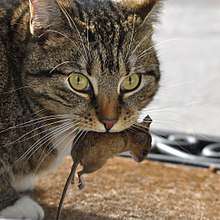
The shape and structure of cats' cheeks is insufficient to suck. They lap with the tongue to draw liquid upwards into their mouths. Lapping at a rate of four times a second, the cat touches the smooth tip of its tongue to the surface of the water, and quickly retracts it like a corkscrew, drawing water upwards.[121][122]
Feral cats and free-fed house cats consume several small meals in a day. The frequency and size of meals varies between individuals. They select food based on its temperature, smell and texture; they dislike chilled foods and respond most strongly to moist foods rich in amino acids, which are similar to meat. Cats reject novel flavors (a response termed neophobia) and learn quickly to avoid foods that have tasted unpleasant in the past.[102][123] They also avoid sweet food and milk. Most adult cats are lactose intolerant; the sugar in milk is not easily digested and may cause soft stools or diarrhea.[124] Some also develop odd eating habits and like to eat or chew on things like wool, plastic, cables, paper, string, aluminum foil, or even coal. This condition, pica, can threaten their health, depending on the amount and toxicity of the items eaten.[125]
Cats hunt small prey, primarily birds and rodents,[126] and are often used as a form of pest control.[127][128] Cats use two hunting strategies, either stalking prey actively, or waiting in ambush until an animal comes close enough to be captured.[129] The strategy used depends on the prey species in the area, with cats waiting in ambush outside burrows, but tending to actively stalk birds.[130]:153 Domestic cats are a major predator of wildlife in the United States, killing an estimated 1.4 to 3.7 billion birds and 6.9 to 20.7 billion mammals annually.[131] Certain species appear more susceptible than others; for example, 30% of house sparrow mortality is linked to the domestic cat.[132] In the recovery of ringed robins (Erithacus rubecula) and dunnocks (Prunella modularis), 31% of deaths were a result of cat predation.[133] In parts of North America, the presence of larger carnivores such as coyotes which prey on cats and other small predators reduces the effect of predation by cats and other small predators such as opossums and raccoons on bird numbers and variety.[134]
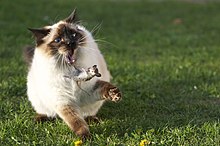
Perhaps the best-known element of cats' hunting behavior, which is commonly misunderstood and often appalls cat owners because it looks like torture, is that cats often appear to "play" with prey by releasing it after capture. This cat and mouse behavior is due to an instinctive imperative to ensure that the prey is weak enough to be killed without endangering the cat.[135] Another poorly understood element of cat hunting behavior is the presentation of prey to human guardians. One explanation is that cats adopt humans into their social group and share excess kill with others in the group according to the dominance hierarchy, in which humans are reacted to as if they are at, or near, the top.[136] Another explanation is that they attempt to teach their guardians to hunt or to help their human as if feeding "an elderly cat, or an inept kitten".[137] This hypothesis is inconsistent with the fact that male cats also bring home prey, despite males having negligible involvement in raising kittens.[130]:153
Impact on wildlife
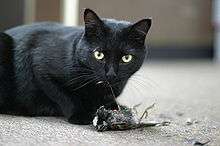
On islands, birds can contribute as much as 60% of a cat's diet.[138] In nearly all cases, however, the cat cannot be identified as the sole cause for reducing the numbers of island birds, and in some instances, eradication of cats has caused a "mesopredator release" effect;[139] where the suppression of top carnivores creates an abundance of smaller predators that cause a severe decline in their shared prey. Domestic cats are, however, known to be a contributing factor to the decline of many species, a factor that has ultimately led, in some cases, to extinction. The South Island piopio, Chatham rail,[133] and the New Zealand merganser[140] are a few from a long list, with the most extreme case being the flightless Lyall's wren, which was driven to extinction only a few years after its discovery.[141][142] One feral cat in New Zealand killed 102 New Zealand lesser short-tailed bats in seven days.[143] In the US, feral and free-ranging domestic cats kill an estimated 6.3 – 22.3 billion mammals annually.[131]
In Australia, the impact of cats on mammal populations is even greater than the impact of habitat loss.[144] More than one million reptiles are killed by feral cats each day, representing 258 species.[145] Cats have contributed to the extinction of the Navassa curly-tailed lizard and Chioninia coctei.[146]
Play
Domestic cats, especially young kittens, are known for their love of play. This behavior mimics hunting and is important in helping kittens learn to stalk, capture, and kill prey.[147] Cats also engage in play fighting, with each other and with humans. This behavior may be a way for cats to practice the skills needed for real combat, and might also reduce any fear they associate with launching attacks on other animals.[148]
Cats also tend to play with toys more when they are hungry.[149] Owing to the close similarity between play and hunting, cats prefer to play with objects that resemble prey, such as small furry toys that move rapidly, but rapidly lose interest. They become habituated to a toy they have played with before.[150] String is often used as a toy, but if it is eaten, it can become caught at the base of the cat's tongue and then move into the intestines, a medical emergency which can cause serious illness, even death.[151] Owing to the risks posed by cats eating string, it is sometimes replaced with a laser pointer's dot, which cats may chase.[152]
Reproduction
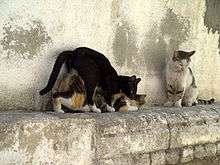
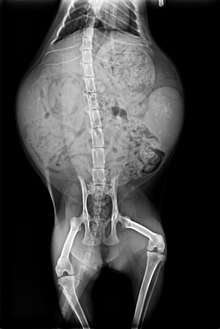
Female cats called queens are polyestrous with several estrus cycles during a year, lasting usually 21 days. They are usually ready to mate between early February and August.[153]
Several males, called tomcats, are attracted to a female in heat. They fight over her, and the victor wins the right to mate. At first, the female rejects the male, but eventually, the female allows the male to mate. The female utters a loud yowl as the male pulls out of her because a male cat's penis has a band of about 120–150 backward-pointing penile spines, which are about 1 mm (1⁄32 in) long; upon withdrawal of the penis, the spines rake the walls of the female's vagina, which acts to induce ovulation. This act also occurs to clear the vagina of other sperm in the context of a second (or more) mating, thus giving the later males a larger chance of conception.[154]
After mating, the female cleans her vulva thoroughly. If a male attempts to mate with her at this point, the female attacks him. After about 20 to 30 minutes, once the female is finished grooming, the cycle will repeat.[155] Because ovulation is not always triggered by a single mating, females may not be impregnated by the first male with which they mate.[156] Furthermore, cats are superfecund; that is, a female may mate with more than one male when she is in heat, with the result that different kittens in a litter may have different fathers.[155]
The morula forms 124 hours after conception. At 148 hours, early blastocysts form. At 10–12 days, implantation occurs.[157] The gestation of queens lasts between 64 and 67 days, with an average of 65 days.[153][158] Data on the reproductive capacity of more than 2,300 free-ranging queens were collected during a study between May 1998 and October 2000. They had one to six kittens per litter, with an average of three kittens. They produced a mean of 1.4 litters per year, but a maximum of three litters in a year. Of 169 kittens, 127 died before they were six months old due to a trauma caused in most cases by dog attacks and road accidents.[9] The first litter is usually smaller than subsequent litters. Kittens are weaned between six and seven weeks of age. Queens normally reach sexual maturity at 5–10 months, and males at 5–7 months. This varies depending on breed.[155] Kittens reach puberty at the age of 9–10 months.[153]
Cats are ready to go to new homes at about 12 weeks of age, when they are ready to leave their mother.[159] They can be surgically sterilized (spayed or castrated) as early as seven weeks to limit unwanted reproduction.[160] This surgery also prevents undesirable sex-related behavior, such as aggression, territory marking (spraying urine) in males and yowling (calling) in females. Traditionally, this surgery was performed at around six to nine months of age, but it is increasingly being performed before puberty, at about three to six months.[161] In the United States, about 80% of household cats are neutered.[162]
Lifespan and health
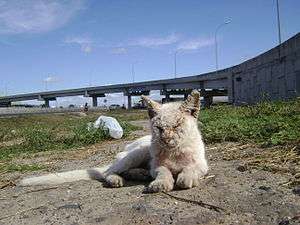
The average lifespan of pet cats has risen in recent decades. In the early 1980s, it was about seven years,[163]:33[164] rising to 9.4 years in 1995[163]:33 and 15.1 years in 2018.[165] Some cats have been reported as surviving into their 30s,[166] with the oldest known cat, Creme Puff, dying at a verified age of 38.[167]
Spaying or neutering increases life expectancy: one study found neutered male cats live twice as long as intact males, while spayed female cats live 62% longer than intact females.[163]:35 Having a cat neutered confers health benefits, because castrated males cannot develop testicular cancer, spayed females cannot develop uterine or ovarian cancer, and both have a reduced risk of mammary cancer.[168]
Despite widespread concern about the welfare of free-roaming cats, the lifespans of neutered feral cats in managed colonies compare favorably with those of pet cats.[169]:45[170]:1358[171][172][173][174]
Disease
About two hundred fifty heritable genetic disorders have been identified in cats, many similar to human inborn errors of metabolism.[175] The high level of similarity among the metabolism of mammals allows many of these feline diseases to be diagnosed using genetic tests that were originally developed for use in humans, as well as the use of cats as animal models in the study of the human diseases.[176][177] Diseases affecting domestic cats include acute infections, parasitic infestations, injuries, and chronic diseases such as kidney disease, thyroid disease, and arthritis. Vaccinations are available for many infectious diseases, as are treatments to eliminate parasites such as worms and fleas.[178]
Ecology
Habitats
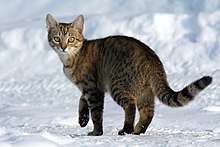
The domestic cat is a cosmopolitan species and occurs across much of the world.[55] It is adaptable and now present on all continents except Antarctica, and on 118 of the 131 main groups of islands—even on isolated islands such as the Kerguelen Islands.[179][180] Due to its ability to thrive in almost any terrestrial habitat, it is among the world's most invasive species.[181] As it is little altered from the wildcat, it can readily interbreed with the wildcat. This hybridization poses a danger to the genetic distinctiveness of some wildcat populations, particularly in Scotland and Hungary and possibly also the Iberian Peninsula.[52] It lives on small islands with no human inhabitants.[182] Feral cats can live in forests, grasslands, tundra, coastal areas, agricultural land, scrublands, urban areas, and wetlands.[183]
Feral cats
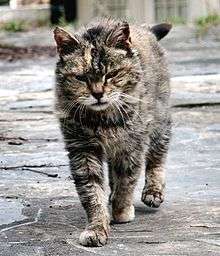
Feral cats are domestic cats that were born in or have reverted to a wild state. They are unfamiliar with and wary of humans and roam freely in urban and rural areas.[10] The numbers of feral cats is not known, but estimates of the United States feral population range from twenty-five to sixty million.[10] Feral cats may live alone, but most are found in large colonies, which occupy a specific territory and are usually associated with a source of food.[184] Famous feral cat colonies are found in Rome around the Colosseum and Forum Romanum, with cats at some of these sites being fed and given medical attention by volunteers.[185]
Public attitudes towards feral cats vary widely, ranging from seeing them as free-ranging pets, to regarding them as vermin.[186] One common approach to reducing the feral cat population is termed "trap-neuter-return", where the cats are trapped, neutered, immunized against diseases such as rabies and the feline panleukopenia and leukemia viruses, and then released.[187] Before releasing them back into their feral colonies, the attending veterinarian often nips the tip off one ear to mark it as neutered and inoculated, since these cats may be trapped again. Volunteers continue to feed and give care to these cats throughout their lives. Given this support, their lifespans are increased, and behavior and nuisance problems caused by competition for food are reduced.[184]
Some feral cats can be successfully socialised and 're-tamed' for adoption; young cats, especially kittens[188] and cats that have had prior experience and contact with humans are the most receptive to these efforts.
Interaction with humans
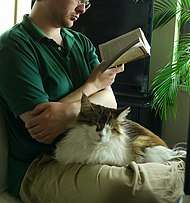
Cats are common pets throughout the world, and their worldwide population exceeds 500 million as of 2007.[189] Cats have been used for millennia to control rodents, notably around grain stores and aboard ships, and both uses extend to the present day.[190][191]
As well as being kept as pets, cats are also used in the international fur[192] and leather industries for making coats, hats, blankets, and stuffed toys;[193] and shoes, gloves, and musical instruments respectively[194] (about 24 cats are needed to make a cat-fur coat).[195] This use has been outlawed in the United States, Australia, and the European Union in 2007.[196] Cat pelts have been used for superstitious purposes as part of the practise of witchcraft,[197] and are still made into blankets in Switzerland as folk remedies believed to help rheumatism.[198] In the Western intellectual tradition, the idea of cats as everyday objects have served to illustrate problems of quantum mechanics in the Schrödinger's cat thought experiment.
A few attempts to build a cat census have been made over the years, both through associations or national and international organizations (such as the Canadian Federation of Humane Societies's one[199]) and over the Internet,[200][201] but such a task does not seem simple to achieve. General estimates for the global population of domestic cats range widely from anywhere between 200 million to 600 million.[202][203][204][205][206] Walter Chandoha made his career photographing cats after his 1949 images of Loco, an especially charming stray taken in, were published around the world. He is reported to have photographed 90,000 cats during his career and maintained an archive of 225,000 images that he drew from for publications during his lifetime.[207]
Cat show
A cat show is a judged event in which the owners of cats compete to win titles in various cat-registering organizations by entering their cats to be judged after a breed standard.[208][209] Both pedigreed and non-purebred companion ("moggy") cats are admissible, although the rules differ from organization to organization. Competing cats are compared to the applicable breed standard,[210] and assessed for temperament and apparent health; the owners of those judged to be most ideal awarded a prize. Moggies are judged based on their temperament and healthy appearance. Some events also include activity judging, such as trained navigation of obstacle course. Often, at the end of the year, all of the points accrued at various shows are added up and more national and regional titles are awarded to champion cats.
Infections transmitted from cats to humans
Cats can be infected or infested with viruses, bacteria, fungus, protozoans, arthropods or worms that can transmit diseases to humans.[211] In some cases, the cat exhibits no symptoms of the disease,[212] However, the same disease can then become evident in a human. The likelihood that a person will become diseased depends on the age and immune status of the person. Humans who have cats living in their home or in close association are more likely to become infected, however, those who do not keep cats as pets might also acquire infections from cat feces and parasites exiting the cat's body.[211][213] Some of the infections of most concern include salmonella, cat-scratch disease and toxoplasmosis.[212]
History and mythology
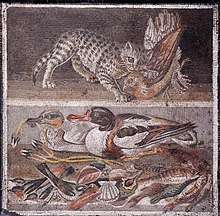
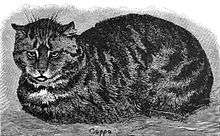
In ancient Egypt, cats were worshipped, and the goddess Bastet often depicted in cat form, sometimes taking on the war-like aspect of a lioness. The Greek historian Herodotus reported that killing a cat was forbidden, and when a household cat died, the entire family mourned and shaved their eyebrows. Families took their dead cats to the sacred city of Bubastis, where they were embalmed and buried in sacred repositories. Herodotus expressed astonishment at the domestic cats in Egypt, because he had only ever seen wildcats.[214] Ancient Greeks and Romans kept weasels as pets, which were seen as the ideal rodent-killers. The earliest unmistakable evidence of the Greeks having domestic cats comes from two coins from Magna Graecia dating to the mid-fifth century BC showing Iokastos and Phalanthos, the legendary founders of Rhegion and Taras respectively, playing with their pet cats. The usual ancient Greek word for 'cat' was ailouros, meaning 'thing with the waving tail'. Cats are rarely mentioned in ancient Greek literature. Aristotle remarked in his History of Animals that "female cats are naturally lecherous." The Greeks later syncretized their own goddess Artemis with the Egyptian goddess Bastet, adopting Bastet's associations with cats and ascribing them to Artemis. In Ovid's Metamorphoses, when the deities flee to Egypt and take animal forms, the goddess Diana turns into a cat.[215][216] Cats eventually displaced ferrets as the pest control of choice because they were more pleasant to have around the house and were more enthusiastic hunters of mice. During the Middle Ages, many of Artemis's associations with cats were grafted onto the Virgin Mary. Cats are often shown in icons of Annunciation and of the Holy Family and, according to Italian folklore, on the same night that Mary gave birth to Jesus, a cat in Bethlehem gave birth to a kitten.[217] Domestic cats were spread throughout much of the rest of the world during the Age of Discovery, as ships' cats were carried on sailing ships to control shipboard rodents and as good-luck charms.[46]
Several ancient religions believed cats are exalted souls, companions or guides for humans, that are all-knowing but mute so they cannot influence decisions made by humans. In Japan, the maneki neko cat is a symbol of good fortune.[218] In Norse mythology, Freyja, the goddess of love, beauty, and fertility, is depicted as riding a chariot drawn by cats.[219] In Jewish legend, the first cat was living in the house of the first man Adam as a pet that got rid of mice. The cat was once partnering with the first dog before the latter broke an oath they had made which resulted in enmity between the descendants of these two animals. It is also written that neither cats nor foxes are represented in the water, while every other animal has an incarnation species in the water.[220] Although no species are sacred in Islam, cats are revered by Muslims. Some Western writers have stated Muhammad had a favorite cat, Muezza.[221] He is reported to have loved cats so much, "he would do without his cloak rather than disturb one that was sleeping on it".[222] The story has no origin in early Muslim writers, and seems to confuse a story of a later Sufi saint, Ahmed ar-Rifa'i, centuries after Muhammad.[223] One of the companions of Muhammad was known as Abu Hurayrah ("father of the kitten"), in reference to his documented affection to cats.[224]
Superstitions and rituals
.jpg)
Many cultures have negative superstitions about cats. An example would be the belief that a black cat "crossing one's path" leads to bad luck, or that cats are witches' familiars used to augment a witch's powers and skills. The killing of cats in Medieval Ypres, Belgium, is commemorated in the innocuous present-day Kattenstoet (cat parade).[225] In medieval France, cats would be burnt alive as a form of entertainment. According to Norman Davies, the assembled people "shrieked with laughter as the animals, howling with pain, were singed, roasted, and finally carbonized".[226]
"It was the custom to burn a basket, barrel, or sack full of live cats, which was hung from a tall mast in the midst of the bonfire; sometimes a fox was burned. The people collected the embers and ashes of the fire and took them home, believing that they brought good luck. The French kings often witnessed these spectacles and even lit the bonfire with their own hands. In 1648 Louis XIV, crowned with a wreath of roses and carrying a bunch of roses in his hand, kindled the fire, danced at it and partook of the banquet afterwards in the town hall. But this was the last occasion when a monarch presided at the midsummer bonfire in Paris. At Metz midsummer fires were lighted with great pomp on the esplanade, and a dozen cats, enclosed in wicker cages, were burned alive in them, to the amusement of the people. Similarly at Gap, in the department of the Hautes-Alpes, cats used to be roasted over the midsummer bonfire."[227]
According to a myth in many cultures, cats have multiple lives. In many countries, they are believed to have nine lives, but in Italy, Germany, Greece, Brazil and some Spanish-speaking regions, they are said to have seven lives,[228][229] while in Turkish and Arabic traditions, the number of lives is six.[230] The myth is attributed to the natural suppleness and swiftness cats exhibit to escape life-threatening situations. Also lending credence to this myth is the fact that falling cats often land on their feet, using an instinctive righting reflex to twist their bodies around. Nonetheless, cats can still be injured or killed by a high fall.[231]
See also
- Aging in cats
- Ailurophobia
- Animal testing on cats
- Animal track
- Big cats
- Cancer in cats
- Cat and mouse (cat-and-mouse game)
- Cat bite
- Cat burning
- Cat café
- Cat intelligence
- Cat lady
- Cat lover culture
- Cat meat
- Cats and the Internet
- Dog–cat relationship
- Dried cat
- List of cat documentaries
- List of cats
- List of fictional cats and felines
- Pet door including cat flap
- Pet first aid
- Popular cat names
References
- Linnaeus, C. (1758). "Felis Catus". Systema naturae per regna tria naturae: secundum classes, ordines, genera, species, cum characteribus, differentiis, synonymis, locis (in Latin). 1 (Tenth reformed ed.). Holmiae: Laurentii Salvii. p. 42.
- Wozencraft, W.C. (2005). "Species Felis catus". In Wilson, D.E.; Reeder, D.M (eds.). Mammal Species of the World: A Taxonomic and Geographic Reference (3rd ed.). Johns Hopkins University Press. pp. 534–535. ISBN 978-0-8018-8221-0. OCLC 62265494.
- Erxleben, J. C. P. (1777). "Felis Catus domesticus". Systema regni animalis per classes, ordines, genera, species, varietates cvm synonymia et historia animalivm. Classis I. Mammalia. Lipsiae: Weygandt. pp. 520–521.
- Clutton-Brock, J. (1999) [1987]. "Cats". A Natural History of Domesticated Mammals (Second ed.). Cambridge, England: Cambridge University Press. pp. 133–140. ISBN 978-0-521-63495-3. OCLC 39786571.
- Liberg, O.; Sandell, M.; Pontier, D. & Natoli, E. (2000). "Density, spatial organisation and reproductive tactics in the domestic cat and other felids". In Turner, D. C. & Bateson, P. (eds.). The domestic cat: the biology of its behaviour (Second ed.). Cambridge: Cambridge University Press. pp. 119–147. ISBN 9780521636483.
- Driscoll, C. A.; Clutton-Brock, J.; Kitchener, A. C. & O'Brien, S. J. (2009). "The taming of the cat". Scientific American. 300 (6): 68–75. Bibcode:2009SciAm.300f..68D. doi:10.1038/scientificamerican0609-68. PMC 5790555. PMID 19485091.
- Moelk, M. (1944). "Vocalizing in the House-cat; A Phonetic and Functional Study". The American Journal of Psychology. 57 (2): 184–205. doi:10.2307/1416947. JSTOR 1416947.
- Bland, K. P. (1979). "Tom-cat odour and other pheromones in feline reproduction" (PDF). Veterinary Science Communications. 3 (1): 125–136. doi:10.1007/BF02268958.
- Nutter, F. B.; Levine, J. F. & Stoskopf, M. K. (2004). "Reproductive capacity of free-roaming domestic cats and kitten survival rate". Journal of the American Veterinary Medical Association. 225 (9): 1399–1402. CiteSeerX 10.1.1.204.1281. doi:10.2460/javma.2004.225.1399. PMID 15552315. S2CID 1903272.
- Rochlitz, I. (2007). The Welfare of Cats. "Animal Welfare" series. Berlin: Springer Science+Business Media. pp. 141–175. ISBN 978-1-4020-6143-1. OCLC 262679891.
- Driscoll, C. A.; Menotti-Raymond, M.; Roca, A. L.; Hupe, K.; Johnson, W. E.; Geffen, E.; Harley, E. H.; Delibes, M.; Pontier, D.; Kitchener, A. C.; Yamaguchi, N.; O'Brien, S. J. & Macdonald, D. W. (2007). "The Near Eastern Origin of Cat Domestication". Science. 317 (5837): 519–523. Bibcode:2007Sci...317..519D. doi:10.1126/science.1139518. ISSN 0036-8075. PMC 5612713. PMID 17600185.
- Langton, N. & Langton, M. B. (1940). The Cat in ancient Egypt, illustrated from the collection of cat and other Egyptian figures formed. Cambridge University Press.
- Malek, J. (1997). The Cat in Ancient Egypt (Revised ed.). Philadelphia: University of Pennsylvania Press.
- "Pet Industry Market Size & Ownership Statistics". American Pet Products Association. Archived from the original on 25 February 2019. Retrieved 25 February 2019.
- "The 5 Most Expensive Cat Breeds in America". moneytalksnews.com. 16 May 2017. Archived from the original on 25 February 2019. Retrieved 25 February 2019.
- "Number of cats in the United States from 2000 to 2017/2018". www.statista.com. Archived from the original on 6 March 2019. Retrieved 3 March 2019.
- "Cat Population 2019". PFMA.org.uk. London: Pet Food Manufacturers Association. 2019.
- McKnight, G.H. (1923). "Words and Archaeology". English Words and Their Background. New York, London: D. Appleton and Company. pp. 293–311.
- Savignac, J.-P. (2004). "Chat". Dictionnaire français-gaulois. Paris: Errance. p. 82.
- Pictet, A. (1859). Les origines indo-européennes ou les Aryas primitifs : essai de paléontologie linguistique. 1. Paris: Joël Cherbuliez. p. 381.
- Keller, O. (1909). Die antike Tierwelt. Säugetiere. Leipzig: Walther von Wartburg. p. 75.
- Huehnergard, J. (2008). "Qitta: Arabic Cats". In Gruendler, B.; Cooperson, M. (eds.). Classical Arabic Humanities in Their Own Terms: Festschrift for Wolfhart Heinrichs on his 65th Birthday. Leiden, Boston: Brill. pp. 407–418. ISBN 9789004165731.
- Kroonen, G. (2013). Etymological Dictionary of Proto-Germanic. Leiden, Netherlands: Brill Publishers. p. 281f. ISBN 978-90-04-18340-7.
- "Puss". The Oxford English Dictionary. Oxford University Press. Archived from the original on 3 September 2015. Retrieved 1 October 2012.
- "puss". Webster's Encyclopedic Unabridged Dictionary of the English Language. New York: Gramercy (Random House). 1996. p. 1571.
- "tom cat, tom-cat". The Oxford English Dictionary. Oxford University Press. Retrieved 1 October 2012.
- "gib, n.2". The Oxford English Dictionary. Archived from the original on 18 September 2018. Retrieved 1 October 2012.
- "queen cat". The Oxford English Dictionary. Archived from the original on 3 September 2015. Retrieved 1 October 2012.
- "catling". The Oxford English Dictionary. Archived from the original on 3 September 2015. Retrieved 1 October 2012.
- "What do you call a group of ...?". Oxford Dictionaries Online. Oxford University Press. Archived from the original on 12 October 2012. Retrieved 1 October 2012.
- Satunin, C. (1904). "The Black Wild Cat of Transcaucasia". Proceedings of the Zoological Society of London. II: 162–163.
- Bukhnikashvili, A.; Yevlampiev, I. (eds.). Catalogue of the Specimens of Caucasian Large Mammalian Fauna in the Collection (PDF). Tbilisi: National Museum of Georgia.
- "Opinion 2027". Bulletin of Zoological Nomenclature. International Commission on Zoological Nomenclature. 60: 81−82. 2003.
- Gentry, A.; Clutton-Brock, J.; Groves, C. P. (2004). "The naming of wild animal species and their domestic derivatives" (PDF). Journal of Archaeological Science. 31 (5): 645–651. doi:10.1016/j.jas.2003.10.006. Archived (PDF) from the original on 4 March 2016. Retrieved 19 January 2019.
- Driscoll, C. A.; Macdonald, D. W.; O'Brien, S. J. (2009). "In the Light of Evolution III: Two Centuries of Darwin Sackler Colloquium: From Wild Animals to Domestic Pets – An Evolutionary View of Domestication". Proceedings of the National Academy of Sciences of the United States of America. 106 (S1): 9971–9978. Bibcode:2009PNAS..106.9971D. doi:10.1073/pnas.0901586106. PMC 2702791. PMID 19528637.
- Wozencraft, W.C. (2005). "Species Felis silvestris". In Wilson, D.E.; Reeder, D.M (eds.). Mammal Species of the World: A Taxonomic and Geographic Reference (3rd ed.). Johns Hopkins University Press. pp. 536–537. ISBN 978-0-8018-8221-0. OCLC 62265494.
- Kitchener, A. C.; Breitenmoser-Würsten, C.; Eizirik, E.; Gentry, A.; Werdelin, L.; Wilting, A.; Yamaguchi, N.; Abramov, A. V.; Christiansen, P.; Driscoll, C.; Duckworth, J. W.; Johnson, W.; Luo, S.-J.; Meijaard, E.; O’Donoghue, P.; Sanderson, J.; Seymour, K.; Bruford, M.; Groves, C.; Hoffmann, M.; Nowell, K.; Timmons, Z.; Tobe, S. (2017). "A revised taxonomy of the Felidae: The final report of the Cat Classification Task Force of the IUCN Cat Specialist Group" (PDF). Cat News. Special Issue 11: 21.
- Johnson, W.E.; O'Brien, S.J. (1997). "Phylogenetic Reconstruction of the Felidae Using 16S rRNA and NADH-5 Mitochondrial Genes". Journal of Molecular Evolution. 44 (S1): S98–S116. Bibcode:1997JMolE..44S..98J. doi:10.1007/PL00000060. PMID 9071018.
- Johnson, W.E.; Eizirik, E.; Pecon-Slattery, J.; Murphy, W.J.; Antunes, A.; Teeling, E.; O'Brien, S.J. (2006). "The late Miocene radiation of modern Felidae: A genetic assessment". Science. 311 (5757): 73–77. Bibcode:2006Sci...311...73J. doi:10.1126/science.1122277. PMID 16400146.
- Mattern, M.Y.; McLennan, D.A. (2000). "Phylogeny and speciation of Felids". Cladistics. 16 (2): 232–253. doi:10.1111/j.1096-0031.2000.tb00354.x.
- Nie, W.; Wang, J.; O'Brien, P.C. (2002). "The genome phylogeny of domestic cat, red panda and five Mustelid species revealed by comparative chromosome painting and G-banding". Chromosome Research. 10 (3): 209–222. doi:10.1023/A:1015292005631. PMID 12067210.
- Pontius, J.U.; Mullikin, J.C.; Smith, D.R.; Agencourt Sequencing Team; et al. (NISC Comparative Sequencing Program) (2007). "Initial sequence and comparative analysis of the cat genome". Genome Research. 17 (11): 1675–1689. doi:10.1101/gr.6380007. PMC 2045150. PMID 17975172.
- Vigne, J.-D.; Evin, A.; Cucchi, T.; Dai, L.; Yu, C.; Hu, S.; Soulages, N.; Wang, W.; Sun, Z. (2016). "Earliest 'domestic' cats in China identified as leopard cat (Prionailurus bengalensis)". PLoS One. 11 (1): e0147295. Bibcode:2016PLoSO..1147295V. doi:10.1371/journal.pone.0147295. PMC 4723238. PMID 26799955.
- Vigne, J.D.; Guilaine, J.; Debue, K.; Haye, L. & Gérard, P. (2004). "Early taming of the cat in Cyprus". Science. 304 (5668): 259. doi:10.1126/science.1095335. PMID 15073370. S2CID 28294367.
- Ottoni, C.; van Neer, W.; de Cupere, B.; Daligault, J.; Guimaraes, S.; Peters, J.; et al. (2017). "The palaeogenetics of cat dispersal in the ancient world". Nature Ecology & Evolution. 1 (7): 0139. doi:10.1038/s41559-017-0139. ISSN 2397-334X. S2CID 44041769.
- Faure, E.; Kitchener, A.C. (2009). "An archaeological and historical review of the relationships between Felids and people". Anthrozoös. 22 (3): 221−238. doi:10.2752/175303709X457577.
- Vigne, J.-D. (1992). "Zooarchaeology and the biogeographical history of the mammals of Corsica and Sardinia since the last ice age". Mammal Review. 22 (2): 87–96. doi:10.1111/j.1365-2907.1992.tb00124.x.
- Ragni, B.; Possenti, M.; Sforzi, A.; Zavalloni, D.; Ciani, F. (1994). "The wildcat in central-northern Italian peninsula: a biogeographical dilemma" (PDF). Biogeographia – the Journal of Integrative Biogeography. 17 (1). doi:10.21426/B617110417.
- Cameron-Beaumont, C.; Lowe, S.E.; Bradshaw, J.W.S. (2002). "Evidence suggesting pre-adaptation to domestication throughout the small Felidae" (PDF). Biological Journal of the Linnean Society. 75 (3): 361–366. doi:10.1046/j.1095-8312.2002.00028.x.
- Bradshaw, J.W.S.; Horsfield, G.F.; Allen, J.A.; Robinson, I.H. (1999). "Feral cats: Their role in the population dynamics of Felis catus" (PDF). Applied Animal Behaviour Science. 65 (3): 273–283. doi:10.1016/S0168-1591(99)00086-6. Archived from the original (PDF) on 30 January 2019.
- Kitchener, C.; Easterbee, N. (1992). "The taxonomic status of black wild felids in Scotland". Journal of Zoology. 227 (2): 342–346. doi:10.1111/j.1469-7998.1992.tb04832.x.
- Oliveira, R.; Godinho, R.; Randi, E.; Alves, P. C. (2008). "Hybridization Versus Conservation: Are Domestic Cats Threatening the Genetic Integrity of Wildcats (Felis silvestris silvestris) in Iberian Peninsula?". Philosophical Transactions of the Royal Society of London. Series B, Biological Sciences. 363 (1505): 2953–2961. doi:10.1098/rstb.2008.0052. PMC 2606743. PMID 18522917.
- Wastlhuber, J. (1991). "History of domestic cats and cat breeds". In Pedersen, N.C. (ed.). Feline Husbandry: Diseases and management in the multiple-cat environment. Goleta: American Veterinary Publications. pp. 1–59. ISBN 9780939674299.
- Montague, M.J.; Li, G.; Gandolfi, B.; Khan, R.; Aken, B.L.; Searle, S.M.; Minx, P.; Hillier, L.W.; Koboldt, D.C.; Davis, B.W.; Driscoll, C.A. (2014). "Comparative analysis of the domestic cat genome reveals genetic signatures underlying feline biology and domestication". Proceedings of the National Academy of Sciences. 111 (48): 17230–17235. Bibcode:2014PNAS..11117230M. doi:10.1073/pnas.1410083111. PMC 4260561. PMID 25385592.
- Lipinski, M.J.; Froenicke, L.; Baysac, K.C.; Billings, N.C.; Leutenegger, C.M.; Levy, A.M.; Longeri, M.; Niini, T.; Ozpinar, H.; Slater, M.R.; Pedersen, N.C.; Lyons, L.A. (2008). "The ascent of cat breeds: Genetic evaluations of breeds and worldwide random-bred populations". Genomics. 91 (1): 12–21. doi:10.1016/j.ygeno.2007.10.009. PMC 2267438. PMID 18060738.
- O'Connor, T.P. (2007). "Wild or domestic? Biometric variation in the cat Felis silvestris" (PDF). International Journal of Osteoarchaeology. 17 (6): 581–595. doi:10.1002/oa.913.
- Sunquist, M.; Sunquist, F. (2002). "Domestic cat". Wild Cats of the World. University of Chicago Press. pp. 99–112. ISBN 978-0-226-77999-7.
- Walker, W.F. (1982). Study of the Cat with Reference to Human Beings (Fourth revised ed.). Thomson Learning/Cengage. ISBN 978-0-03-057914-1.
- Gillis, R., ed. (2002). "Cat Skeleton". Zoolab. La Crosse: University of Wisconsin Press. Archived from the original on 6 December 2006. Retrieved 7 September 2012.
- Case, Linda P. (2003). The Cat: Its behavior, nutrition, and health. Ames: Iowa State University Press. ISBN 978-0-8138-0331-9.
- Smith, Patricia; Tchernov, Eitan (1992). Structure, Function, and Evolution of Teeth. Freund Publishing House. p. 217. ISBN 978-965-222-270-1.
- Carr, William H.A. (1 January 1978). The New Basic Book of the Cat. Scribner's. p. 174. ISBN 978-0-684-15549-4.
- Pocock, R.I. (1917). "VII — On the external characters of the Felidæ". The Annals and Magazine of Natural History; Zoology, Botany, and Geology. 8. 19 (109): 113–136. doi:10.1080/00222931709486916.
- Christensen, W. (2004). "The physical cat". Outwitting Cats. Globe Pequot. pp. 22–45. ISBN 978-1-59228-240-1.
- Kitchener, A.C.; Van Valkenburgh, B.; Yamaguchi, N. (2010). "Felid form and function". In Macdonald, D.; Loveridge, A. (eds.). Biology and Conservation of wild felids. Oxford University Press. pp. 83–106.
- Armes, A.F. (1900). "Outline of cat lessons". The School Journal. LXI: 659.
- Homberger DG, Ham K, Ogunbakin T, Bonin JA, Hopkins BA, Osborn ML, et al. (2009). "The structure of the cornified claw sheath in the domesticated cat (Felis catus): Implications for the claw-shedding mechanism and the evolution of cornified digital end organs". J Anat. 214 (4): 620–43. doi:10.1111/j.1469-7580.2009.01068.x. PMC 2736126. PMID 19422432.
- Danforth, C.H. (1947). "Heredity of polydactyly in the cat". The Journal of Heredity. 38 (4): 107–112. doi:10.1093/oxfordjournals.jhered.a105701. PMID 20242531.
- Lettice, L.A.; Hill, A.E.; Devenney, P.S.; Hill, R.E. (2008). "Point mutations in a distant sonic hedgehog cis-regulator generate a variable regulatory output responsible for preaxial polydactyly". Human Molecular Genetics. 17 (7): 978–985. doi:10.1093/hmg/ddm370. PMID 18156157.
- Ollivier, F.J.; Samuelson, D.A.; Brooks, D.E.; Lewis, P.A.; Kallberg, M.E.; Komaromy, A.M. (2004). "Comparative morphology of the Tapetum Lucidum (among selected species)". Veterinary Ophthalmology. 7 (1): 11–22. doi:10.1111/j.1463-5224.2004.00318.x. PMID 14738502. S2CID 15419778.
- Malmström, T.; Kröger, R.H. (2006). "Pupil shapes and lens optics in the eyes of terrestrial vertebrates". Journal of Experimental Biology. 209 (1): 18–25. doi:10.1242/jeb.01959. PMID 16354774.
- Hammond, P.; Mouat, G.S.V. (1985). "The relationship between feline pupil size and luminance". Experimental Brain Research. 59 (3): 485–490. doi:10.1007/BF00261338. PMID 4029324.
- Loop, M.S.; Bruce, L.L. (1978). "Cat color vision: The effect of stimulus size". Science. 199 (4334): 1221–1222. Bibcode:1978Sci...199.1221L. doi:10.1126/science.628838. PMID 628838.
- Guenther, E.; Zrenner, E. (1993). "The spectral sensitivity of dark- and light-adapted cat retinal ganglion cells" (PDF). Journal of Neuroscience. 13 (4): 1543–1550. doi:10.1523/JNEUROSCI.13-04-01543.1993. PMC 6576706. PMID 8463834.
- Heffner, R.S. (1985). "Hearing range of the domestic cat" (PDF). Hearing Research. 19 (1): 85–88. doi:10.1016/0378-5955(85)90100-5. PMID 4066516.
- Heffner, H.E. (1998). "Auditory awareness". Applied Animal Behaviour Science. 57 (3–4): 259–268. doi:10.1016/S0168-1591(98)00101-4.
- Heffner, R.S. (2004). "Primate hearing from a mammalian perspective". The Anatomical Record Part A: Discoveries in Molecular, Cellular, and Evolutionary Biology. 281 (1): 1111–1122. doi:10.1002/ar.a.20117. PMID 15472899. S2CID 4991969.
- Sunquist, M.; Sunquist, F. (2002). "What is a Cat?". Wild Cats of the World. University of Chicago Press. pp. 5–18. ISBN 978-0-226-77999-7.
- Blumberg, M.S. (1992). "Rodent ultrasonic short calls: Locomotion, biomechanics, and communication". Journal of Comparative Psychology. 106 (4): 360–365. doi:10.1037/0735-7036.106.4.360. PMID 1451418.
- Moulton, David G. (1 August 1967). "Olfaction in mammals". American Zoologist. 7 (3): 421–429. doi:10.1093/icb/7.3.421. ISSN 0003-1569. PMID 6077376.
- Miyazaki, Masao; Yamashita, Tetsuro; Suzuki, Yusuke; Saito, Yoshihiro; Soeta, Satoshi; Taira, Hideharu; Suzuki, Akemi (October 2006). "A major urinary protein of the domestic ccat regulates the production of felinine, a putative pheromone precursor". Chemistry & Biology. 13 (10): 1071–1079. doi:10.1016/j.chembiol.2006.08.013. PMID 17052611.
- Sommerville, B. A. (1998). "Olfactory Awareness". Applied Animal Behaviour Science. 57 (3–4): 269–286. doi:10.1016/S0168-1591(98)00102-6.
- Grognet, Jeff (June 1990). "Catnip: Its uses and effects, past and present". The Canadian Veterinary Journal. 31 (6): 455–456. PMC 1480656. PMID 17423611.
- Turner, Ramona (29 May 2007). "How does catnip work its magic on cats?". Scientific American. Archived from the original on 22 October 2013.
- Tucker, Arthur; Tucker, Sharon (1988). "Catnip and the catnip response". Economic Botany. 42 (2): 214–231. doi:10.1007/BF02858923.
- Schelling, Christianne. "Do cats have a sense of taste?". CatHealth.com. Archived from the original on 28 January 2016.
- "Why cats can't taste sweets". Petside.com. 13 March 2012. Archived from the original on 25 January 2013. Retrieved 11 January 2013.
- Bradshaw, John W.S. (1 July 2006). "The evolutionary basis for the feeding behavior of domestic dogs (Canis familiaris) and cats (Felis catus)". Journal of Nutrition. 136 (7): 1927S–1931. doi:10.1093/jn/136.7.1927S. PMID 16772461.
- Kent, Marc; Platt, Simon R. (September 2010). "The neurology of balance: Function and dysfunction of the vestibular system in dogs and cats". The Veterinary Journal. 185 (3): 247–249. doi:10.1016/j.tvjl.2009.10.029. PMID 19944632.
- Gerathewohl, S.J.; Stallings, H.D. (1957). "The labyrinthine posture reflex (righting reflex) in the cat during weightlessness" (PDF). The Journal of Aviation Medicine. 28 (4): 345–355. PMID 13462942.
- Nguyen, H.D. (1998). "How does a cat always land on its feet?". School of Medical Engineering. Dynamics II (ME 3760) course materials. Georgia Institute of Technology. Archived from the original on 10 April 2001. Retrieved 15 May 2007. This tertiary source reuses information from other sources but does not name them.
- Marey, E.-J. (1894). "Mecanique animale: Des mouvements que certains animaux exécutent pour retomber sur leurs pieds, lorsqu'ils sont précipités d'un lieu élevé". Comptes Rendus de l'Académie des Sciences. 119 (18): 714–717.
- McDonald, D.A. (1955). "How does a falling cat turn over". American Journal of Physiology (129): 34–35.
- Zhen, S.; Huang, K.; Zhao, H.; Chen, Y.H. (2014). "Why can a free-falling cat always manage to land safely on its feet?". Nonlinear Dynamics. 79 (4): 2237–2250. doi:10.1007/s11071-014-1741-2.
- Germain, E.; Benhamou, S.; Poulle, M.-L. (2008). "Spatio-temporal Sharing between the European Wildcat, the Domestic Cat and their Hybrids". Journal of Zoology. 276 (2): 195–203. doi:10.1111/j.1469-7998.2008.00479.x.
- Barratt, D. G. (1997). "Home Range Size, Habitat Utilisation and Movement Patterns of Suburban and Farm Cats Felis catus". Ecography. 20 (3): 271–280. doi:10.1111/j.1600-0587.1997.tb00371.x. JSTOR 3682838.
- Randall, W.; Johnson, R. F.; Randall, S.; Cunningham, J. T. (1985). "Circadian rhythms in food intake and activity in domestic cats". Behavioral Neuroscience. 99 (6): 1162–1175. doi:10.1037/0735-7044.99.6.1162. PMID 3843546.
- Jouvet, M. (1979). "What Does a Cat Dream About?". Trends in Neurosciences. 2: 280–282. doi:10.1016/0166-2236(79)90110-3.
- Pontier, D.; Natoli, E. (1996). "Male Reproductive Success in the Domestic Cat (Felis catus L.): A Case History". Behavioural Processes. 37 (1): 85–88. doi:10.1016/0376-6357(95)00070-4. PMID 24897162.
- Crowell-Davis, S. L.; Curtis, T. M.; Knowles, R. J. (2004). "Social Organization in the Cat: A Modern Understanding" (PDF). Journal of Feline Medicine and Surgery. 6 (1): 19–28. doi:10.1016/j.jfms.2003.09.013. PMID 15123163. Archived from the original (PDF) on 20 July 2011.
- Baron, A.; Stewart, C. N.; Warren, J. M. (1 January 1957). "Patterns of Social Interaction in Cats (Felis domestica)". Behaviour. 11 (1): 56–66. doi:10.1163/156853956X00084. JSTOR 4532869.
- Bradshaw, J.W.; Goodwin, D.; Legrand-Defrétin, V.; Nott, H.M. (1996). "Food selection by the domestic cat, an obligate carnivore". Comparative Biochemistry and Physiology – Part A: Molecular & Integrative Physiology. 114 (3): 205–209. doi:10.1016/0300-9629(95)02133-7. PMID 8759144.
- Levine, E.; Perry, P.; Scarlett, J.; Houpt, K. (2005). "Intercat Aggression in Households Following the Introduction of a New Cat" (PDF). Applied Animal Behaviour Science. 90 (3–4): 325–336. doi:10.1016/j.applanim.2004.07.006. Archived from the original (PDF) on 26 March 2009.
- Mills, D. S.; Marchant-Forde, J. (2010). Encyclopedia of Applied Animal Behaviour and Welfare. p. 518. ISBN 978-0-85199-724-7. Archived from the original on 7 April 2017.
- McComb, K.; Taylor, A. M.; Wilson, C.; Charlton, B. D. (2009). "The Cry Embedded within the Purr". Current Biology. 19 (13): R507–508. doi:10.1016/j.cub.2009.05.033. PMID 19602409.
- Soennichsen, S.; Chamove, A. S. (2015). "Responses of cats to petting by humans". Anthrozoös. 15 (3): 258–265. doi:10.2752/089279302786992577.
- Cafazzo, S.; Natoli, E. (2009). "The Social Function of Tail Up in the Domestic Cat (Felis silvestris catus)". Behavioural Processes. 80 (1): 60–66. doi:10.1016/j.beproc.2008.09.008. PMID 18930121.
- Jensen, P. (2009). The Ethology of Domestic Animals. "Modular Text" series. Wallingford, England: Centre for Agriculture and Bioscience International. ISBN 978-1-84593-536-8.
- von Muggenthaler, E.; Wright, B. "Solving the Cat's Purr Mystery Using Accelerometers". BKSV.com. Brüel & Kjær. Archived from the original on 22 July 2011. Retrieved 11 February 2010.
- "The Cat's Remarkable Purr". ISnare.com. Archived from the original on 13 July 2011. Retrieved 6 August 2008.
- "Why and How Do Cats Purr?". Everyday Mysteries: Fun Science Facts from the Library of Congress. Washington DC: Library of Congress. Archived from the original on 3 April 2011. Retrieved 10 April 2011.
- Hadzima, Eva (2016). "Everything You Need to Know About Hairballs". Archived from the original on 6 October 2016. Retrieved 23 August 2016.
- Boshel, J.; Wilborn, W. H; Singh, B. B.; Peter, S.; Stur, M. (1982). "Filiform Papillae of Cat Tongue". Acta Anatomica. 114 (2): 97–105. doi:10.1159/000145583. PMID 7180385. S2CID 36216103.
- Lindell, E. M. (1997). "Intercat Aggression: A Retrospective Study Examining Types of Aggression, Sexes of Fighting Pairs, and Effectiveness of Treatment". Applied Animal Behaviour Science. 55 (1–2): 153–162. doi:10.1016/S0168-1591(97)00032-4.
- Yamane, A.; Doi, T.; Ono, Y. (1996). "Mating Behaviors, Courtship Rank and Mating Success of Male Feral Cat (Felis catus)". Journal of Ethology. 14 (1): 35–44. doi:10.1007/BF02350090.
- Kustritz, M. V. R. (2007). "Determining the Optimal age for Gonadectomy of Dogs and Cats". Journal of the American Veterinary Medical Association. 231 (11): 1665–1675. doi:10.2460/javma.231.11.1665. PMID 18052800. S2CID 4651194.
- "Cat Behavior: Body Language". AnimalPlanet.com. 2007. Archived from the original on 24 February 2009. Retrieved 7 September 2012.
- "Aggression Between Family Cats". HSUS.org. Humane Society of the United States. 2002. Archived from the original on 14 December 2004.
- Pedersen, N. C.; Yamamoto, J. K.; Ishida, T.; Hansen, H. (1989). "Feline Immunodeficiency Virus Infection". Veterinary Immunology and Immunopathology. 21 (1): 111–129. doi:10.1016/0165-2427(89)90134-7. PMID 2549690.
- Whiteley, H. E. (1994). "Correcting misbehavior". Understanding and Training Your Cat or Kitten. Santa Fe: Sunstone Press. pp. 146–147. ISBN 9781611390803.
- Reis, P.M.; Jung, S.; Aristoff, J.M.; Stocker, R. (2010). "How cats lap: Water uptake by Felis catus". Science. 330 (6008): 1231–1234. Bibcode:2010Sci...330.1231R. doi:10.1126/science.1195421. PMID 21071630. S2CID 1917972.
- Kim, W.; Bush, J.W.M. (2012). "Natural drinking strategies" (PDF). Journal of Fluid Mechanics. 705: 7–25. Bibcode:2012JFM...705....7K. doi:10.1017/jfm.2012.122. hdl:1721.1/80405.
- Zaghini, G.; Biagi, G. (2005). "Nutritional peculiarities and diet palatability in the cat". Veterinary Res. Commun. 29 (Supplement 2): 39–44. doi:10.1007/s11259-005-0009-1. PMID 16244923.
- Kienzle, E. (1994). "Blood sugar levels and renal sugar excretion after the intake of high carbohydrate diets in cats" (PDF). Journal of Nutrition. 124 (12 Supplement): 2563S–2567S. doi:10.1093/jn/124.suppl_12.2563S. PMID 7996238. Archived from the original (PDF) on 3 September 2013.
- Bradshaw, J.W.S. (1997). "Factors affecting pica in the domestic cat". Applied Animal Behaviour Science. 52 (3–4): 373–379. doi:10.1016/S0168-1591(96)01136-7.
- Woods, M.; McDonald, R.A.; Harris, S. (2003). "Predation of wildlife by domestic cats Felis catus in Great Britain". Mammal Review. 23 (2): 174–188. doi:10.1046/j.1365-2907.2003.00017.x. S2CID 42095020.
- Slesnick, I.L. (2004). Clones, Cats, and Chemicals: Thinking scientifically about controversial issues. p. 9.
- Hill, D.S. (2008). Pests of Crops in Warmer Climates and their Control (1st ed.). Springer. p. 120. ISBN 978-140206737-2 – via archive.org.
- Tucker, A. "How cats evolved to win the Internet". The New York Times. Archived from the original on 19 October 2016. Retrieved 13 November 2016.
- Turner, D.C.; Bateson, P., eds. (2000). The Domestic Cat: The biology of its behaviour (2nd ed.). Cambridge University Press. ISBN 978-0-521-63648-3.
- Loss, S.R.; Will, T.; Marra, P.P. (2013). "The impact of free-ranging domestic cats on wildlife of the United States". Nature Communications. 4: 1396. Bibcode:2013NatCo...4.1396L. doi:10.1038/ncomms2380. PMID 23360987.
- Chucher, P.B.; Lawton, J.H. (1987). "Predation by domestic cats in an English village". Journal of Zoology, London. 212 (3): 439–455. doi:10.1111/j.1469-7998.1987.tb02915.x.
- Mead, C.J. (1982). "Ringed birds killed by cats". Mammal Review. 12 (4): 183–186. doi:10.1111/j.1365-2907.1982.tb00014.x.
- Crooks, K.R.; Soul, M.E. (1999). "Mesopredator release and avifaunal extinctions in a fragmented system" (PDF). Nature. 400 (6744): 563–566. Bibcode:1999Natur.400..563C. doi:10.1038/23028. Archived from the original (PDF) on 20 July 2011.
- "Why do cats play with their food?". Arizona Daily Sun. Archived from the original on 19 March 2011. Retrieved 15 August 2011.
- Leyhausen, P. (1978). Cat Behavior: The predatory and social behavior of domestic and wild cats. New York: Garland STPM Press. ISBN 978-0-8240-7017-5.
- Desmond, M. (2002). "Why does a cat play with its prey before killing it?". Catwatching: Why cats purr and everything else you ever wanted to know (2nd ed.). London: Ebury Press. pp. 51–52. ISBN 9781409022213.
- Fitzgerald, M. B. & Turner, D. C. "Hunting Behaviour of Domestic Cats and Their Impact on Prey Populations". In Turner & Bateson (ed.). The Domestic Cat: The Biology of its Behaviour. pp. 151–175.
- Courchamp, F.; Langlais, M. & Sugihara, G. (1999). "Cats protecting birds: modelling the mesopredator release effect". Journal of Animal Ecology. 68 (2): 282–292. doi:10.1046/j.1365-2656.1999.00285.x. S2CID 31313856.
- Stattersfield, A. J.; Crosby, M. J.; Long, A. J. & Wege, D. C. (1998). Endemic Bird Areas of the World: Priorities for Biodiversity Conservation. "BirdLife Conservation Series" No. 7. Cambridge, England: Burlington Press. ISBN 978-0-946888-33-7.
- Falla, R. A. (1955). New Zealand Bird Life Past and Present. Cawthron Institute.
- Galbreath, R. & Brown, D. (2004). "The Tale of the Lighthouse-keeper's Cat: Discovery and Extinction of the Stephens Island Wren (Traversia lyalli)" (PDF). Notornis. 51: 193–200. Archived from the original (PDF) on 17 October 2008.
- Scrimgeour, J.; Beath, A. & Swanney, M. (2012). "Cat predation of short-tailed bats (Mystacina tuberculata rhyocobia) in Rangataua Forest, Mount Ruapehu, Central North Island, New Zealand". New Zealand Journal of Zoology. 39 (3): 257–260. doi:10.1080/03014223.2011.649770.
- Murphy, B. P.; Woolley, L.-A.; Geyle, H. M.; Legge, S. M.; Palmer, R.; Dickman, C. R.; Augusteyn, J.; Brown, S. C.; Comer, S.; Doherty, T. S. & Eager, C. (2019). "Introduced cats (Felis catus) eating a continental fauna: The number of mammals killed in Australia". Biological Conservation. 237: 28–40. doi:10.1016/j.biocon.2019.06.013.
- Daley, J. (2018). "Australian Feral Cats Eat More Than a Million Reptiles Per Day". Smithsonian Magazine. Retrieved 6 June 2020.
- Doherty, T. S.; Glen, A. S.; Nimmo, D. G.; Ritchie, E. G. & Dickman, C. R. (2016). "Invasive predators and global biodiversity loss". Proceedings of the National Academy of Sciences. 113 (40): 11261–11265. doi:10.1073/pnas.1602480113. PMC 5056110. PMID 27638204.
- Poirier, F. E.; Hussey, L. K. (1982). "Nonhuman Primate Learning: The Importance of Learning from an Evolutionary Perspective". Anthropology and Education Quarterly. 13 (2): 133–148. doi:10.1525/aeq.1982.13.2.05x1830j. JSTOR 3216627.
- Hall, S. L. (1998). "Object play by adult animals". In Byers, J. A.; Bekoff, M. (eds.). Animal Play: Evolutionary, Comparative, and Ecological Perspectives. Cambridge University Press. pp. 45–60. ISBN 978-0-521-58656-6.
- Hall, S. L. (1998). "The Influence of Hunger on Object Play by Adult Domestic Cats". Applied Animal Behaviour Science. 58 (1–2): 143–150. doi:10.1016/S0168-1591(97)00136-6.
- Hall, S. L. (2002). "Object Play in Adult Domestic Cats: The Roles of Habituation and Disinhibition". Applied Animal Behaviour Science. 79 (3): 263–271. doi:10.1016/S0168-1591(02)00153-3.
- MacPhail, C. (2002). "Gastrointestinal obstruction". Clinical Techniques in Small Animal Practice. 17 (4): 178–183. doi:10.1053/svms.2002.36606. PMID 12587284.
- "Fat Indoor Cats Need Exercise". Pocono Record. 2006. Archived from the original on 14 July 2009. This tertiary source reuses information from other sources but does not name them.
- Jemmett, J. E.; Evans, J. M. (1977). "A survey of sexual behaviour and reproduction of female cats". Journal of Small Animal Practice. 18 (1): 31–37. doi:10.1111/j.1748-5827.1977.tb05821.x. PMID 853730.
- Aronson, L. R.; Cooper, M. L. (1967). "Penile Spines of the Domestic Cat: Their Endocrine-behavior Relations" (PDF). The Anatomical Record. 157 (1): 71–78. doi:10.1002/ar.1091570111. PMID 6030760. Archived from the original (PDF) on 19 March 2015.
- "Prolific Cats: The Estrous Cycle" (PDF). Veterinary Learning Systems. Archived from the original (PDF) on 9 December 2016. Retrieved 19 June 2009.
- Wildt, D. E.; Seager, S. W.; Chakraborty, P. K. (1980). "Effect of Copulatory Stimuli on Incidence of Ovulation and on Serum Luteinizing Hormone in the Cat". Endocrinology. 107 (4): 1212–1217. doi:10.1210/endo-107-4-1212. PMID 7190893.
- Swanson, W. F.; Roth, T. L.; Wilt, D. E. (1994). "In Vivo Embryogenesis, Embryo Migration and Embryonic Mortality in the Domestic Cat". Biology of Reproduction. 51 (3): 452–464. doi:10.1095/biolreprod51.3.452. PMID 7803616.
- Tsutsui, T.; Stabenfeldt, G. H. (1993). "Biology of Ovarian Cycles, Pregnancy and pseudopregnancy in the Domestic Cat". Journal of Reproduction and Fertility. Supplement 47: 29–35. PMID 8229938.
- Behrend, K.; Wegler, M. (1991). "Living with a Cat". The Complete Book of Cat Care: How to Raise a Happy and Healthy Cat. Hauppauge, New York: Barron's Educational Series. pp. 28–29. ISBN 978-0-8120-4613-7.
- Olson, P. N.; Kustritz, M. V.; Johnston, S. D. (2001). "Early-age Neutering of Dogs and Cats in the United States (A Review)". Journal of Reproduction and Fertility. Supplement 57: 223–232. PMID 11787153.
- Root Kustritz, M. V. (2007). "Determining the optimal age for gonadectomy of dogs and cats" (PDF). Journal of American Veterinary Medicine. 231 (11): 1665–1675. doi:10.2460/javma.231.11.1665. PMID 18052800. Archived from the original (PDF) on 13 July 2010.
- Chu, K.; Anderson, W. M.; Rieser, M. Y. (2009). "Population characteristics and neuter status of cats living in households in the United States". Journal of the American Veterinary Medical Association. 234 (8): 1023–1030. doi:10.2460/javma.234.8.1023. PMID 19366332. S2CID 39208758.
- Kraft, W. (February 1998). "Geriatrics in canine and feline internal medicine". European Journal of Medical Research. 3 (1–2): 31–41. PMID 9512965.
- Nassar R, Mosier JE, Williams LW (February 1984). "Study of the feline and canine populations in the greater Las Vegas area". American Journal of Veterinary Research. 45 (2): 282–287. PMID 6711951.
- "What Is the Average Lifespan of a Cat?". The Spruce Pets. Archived from the original on 12 June 2018. Retrieved 6 June 2018.
- Example: "Me-wow! Texas Woman Says Cat is 30 Years Old – Although She Can't Hear or See Very Well, Caterack the Cat Is Still Purring". MSNBC.MSN.com. New York: Microsoft. 30 September 2009. Archived from the original on 2 October 2009. Retrieved 30 September 2009.
- Guinness World Records (reprint ed.). Bantam Books. 2010. p. 320. ISBN 978-0-553-59337-2.
The oldest cat ever was Creme Puff, who was born on August 3, 1967 and lived until August 6, 2005 – 38 years and 3 days in total.
- "Cat Care: Spay–Neuter". ASPCA.org. New York: American Society for the Prevention of Cruelty to Animals. 2011. Archived from the original on 15 April 2012. Retrieved 14 December 2011. This tertiary source reuses information from other sources but does not name them.
- Levy, Julie K.; Gale, David W.; Gale, Leslie A. (January 2003). "Evaluation of the effect of a long-term trap-neuter-return and adoption program on a free-roaming cat population". Journal of the American Veterinary Medical Association. 222 (1): 42–46. doi:10.2460/javma.2003.222.42. PMID 12523478. S2CID 13398546.
- Levy, Julie K.; Crawford, P. Cynda (November 2004). "Humane strategies for controlling feral cat populations". Journal of the American Veterinary Medical Association. 225 (9): 1354–1360. doi:10.2460/javma.2004.225.1354. PMID 15552308. S2CID 16619209.
- A number of the four remaining colony cats at the Parliament Hill Cat Sanctuary in Ottawa, Ontario, Canada were 15 and 16 years old in 2013. "A beloved Parliament Hill attraction uses up its nine lives" Archived 20 August 2016 at the Wayback Machine, Karan Smith, The Globe and Mail, 1 February 2013.
- J. Remfry, Feral Cats in the United Kingdom (JAVMA Vol. 208, No. 4, 15 February 1996, pp. 520–523), at p. 522, available online at pp. 24–27 of "AVMA Animal Welfare Forum: The welfare of cats" Archived 19 August 2014 at the Wayback Machine, 3 November 1995.
- Zorro, the last cat of a colony at the Merrimack River in Newburyport, Massachusetts, died in 2009 at age 16. "Trap-Neuter-Return Effectively Stabilizes and Reduces Feral Cat Populations: Trap-Neuter-Return Humanely Stabilized and Reduced in Size the Merrimack River Colony" Archived 5 March 2016 at the Wayback Machine, Alley Cat Allies, accessed 18 August 2014; an earlier article in the LA Times was written when Zorro was the last remaining living cat: "Advocates report success with trap, neuter, return approach to stray cats" Archived 6 March 2016 at the Wayback Machine, Los Angeles Times, 29 September 2009.
- The last cat in a managed colony in Washington, D.C. died at age 17. "Trap-Neuter-Return Effectively Stabilizes and Reduces Feral Cat Populations: Washington, D.C. Cat Colony Stabilized and Eventually Reduced to Zero" Archived 5 March 2016 at the Wayback Machine, Alley Cat Allies, accessed 18 August 2014.
- O'Brien, S. J.; Johnson, W.; Driscoll, C.; Pontius, J.; Pecon-Slattery, J.; Menotti-Raymond, M. (2008). "State of Cat Genomics". Trends in Genetics. 24 (6): 268–279. doi:10.1016/j.tig.2008.03.004. PMC 7126825. PMID 18471926.
- Sewell, A. C.; Haskins, M. E.; Giger, U. (2007). "Inherited Metabolic Disease in Companion Animals: Searching for Nature's Mistakes". Veterinary Journal. 174 (2): 252–259. doi:10.1016/j.tvjl.2006.08.017. PMC 3132193. PMID 17085062.
- O'Brien, Stephen J.; Menotti-Raymond, M.; Murphy, W. J.; Yuhki, N. (2002). "The Feline Genome Project". Annual Review of Genetics. 36: 657–686. doi:10.1146/annurev.genet.36.060602.145553. PMID 12359739.
- Huston, Lorie (2012). "Veterinary Care for Your New Cat". PetMD. Archived from the original on 8 May 2017. Retrieved 31 January 2017.
- Say, L. (2002). "Spatio-temporal variation in cat population density in a sub-Antarctic environment". Polar Biology. 25 (2): 90–95. doi:10.1007/s003000100316.
- Frenot, Y.; Chown, S. L.; Whinam, J.; Selkirk, P. M.; Convey, P.; Skotnicki, M.; Bergstrom, D. M. (2005). "Biological Invasions in the Antarctic: Extent, Impacts and Implications". Biological Reviews. 80 (1): 45–72. doi:10.1017/S1464793104006542. PMID 15727038. S2CID 5574897.
- Medina, F. M.; Bonnaud, E.; Vidal, E.; Tershy, B. R.; Zavaleta, E.; Josh Donlan, C.; Keitt, B. S.; Le Corre, M.; Horwath, S. V.; Nogales, M. (2011). "A global review of the impacts of invasive cats on island endangered vertebrates". Global Change Biology. 17 (11): 3503–3510. Bibcode:2011GCBio..17.3503M. CiteSeerX 10.1.1.701.4082. doi:10.1111/j.1365-2486.2011.02464.x.
- Nogales, M.; Martin, A.; Tershy, B. R.; Donlan, C. J.; Veitch, D.; Uerta, N.; Wood, B.; Alonso, J. (2004). "A Review of Feral Cat Eradication on Islands" (PDF). Conservation Biology. 18 (2): 310–319. doi:10.1111/j.1523-1739.2004.00442.x. hdl:10261/22249.
- Invasive Species Specialist Group (2006). "Ecology of Felis catus". Global Invasive Species Database. Species Survival Commission, International Union for Conservation of Nature. Archived from the original on 27 October 2009. Retrieved 31 August 2009.
- "What is the difference between a stray cat and a feral cat?". HSUS.org. Humane Society of the United States. 2 January 2008. Archived from the original on 1 May 2008.
- "Torre Argentina cat shelter". Archived from the original on 22 January 2009. Retrieved 17 June 2009.
- Rowan, Andrew N.; Salem, Deborah J. (November 2003). "4" (PDF). The State of the Animals II: 2003. Humane Society of the United States. ISBN 978-0-9658942-7-2. Archived from the original (PDF) on 10 November 2006.
- "2013 AAFP Feline Vaccination Advisory Panel Report" (PDF). Journal of Feline Medicine and Surgery: 9. 2013. Archived (PDF) from the original on 11 August 2017. Retrieved 10 August 2017.
- "Socialising Feral Kittens -". www.animaladvocacy.ie. Retrieved 10 March 2020.
- Wade, N. (2007). "Study Traces Cat's Ancestry to Middle East". The New York Times. Archived from the original on 18 April 2009. Retrieved 2 April 2008.
- Beadle, Muriel (1979). Cat. Simon and Schuster. pp. 93–96. ISBN 9780671251901.
- Mayers, Barbara (2007). Toolbox: Ship's Cat on the Kalmar Nyckel. Bay Oak Publishers, Limited. ISBN 978-0-9741713-9-5.
- "What Is That They're Wearing?" (PDF). Humane Society of the United States. Archived from the original (PDF) on 1 December 2006. Retrieved 22 October 2009.
- Stallwood, K. W., ed. (2002). A Primer on Animal Rights: Leading Experts Write about Animal Cruelty and Exploitation. Lantern Books.
- "Japan: Finale for the world's most elegant use of a dead cat". The Independent. 15 November 1997. Archived from the original on 21 June 2017.
- "EU proposes cat and dog fur ban". BBC News. 2006. Archived from the original on 2 January 2009. Retrieved 22 October 2009.
- Ikuma, C. (2007). "EU Announces Strict Ban on Dog and Cat Fur Imports and Exports". Humane Society International. Archived from the original on 17 February 2009. Retrieved 14 December 2011.
- Jolly, Karen Louise; Raudvere, Catharina; Peters, Edward (2002). Witchcraft and Magic in Europe. Vol. 3: The Middle Ages. London: Athlone. ISBN 978-0-567-57446-6. OCLC 747103210.
- Paterson, T. (2008). "Switzerland Finds a Way to Skin a Cat for the Fur Trade and High Fashion". The Independent. London. Archived from the original on 7 July 2009. Retrieved 23 October 2009.
- "Humane society launches national cat census". CBC News. Archived from the original on 24 October 2012. Retrieved 18 September 2012.
- "Cats Be". Archived from the original on 22 September 2012. Retrieved 18 September 2012.
- "The Supreme Cat Census". Archived from the original on 16 March 2012. Retrieved 18 September 2012.
- "About Pets". IFAHEurope.org. Animal Health Europe. Archived from the original on 6 October 2014. Retrieved 3 October 2014.
- Legay, J. M. (1986). "Sur une tentative d'estimation du nombre total de chats domestiques dans le monde" [Tentative estimation of the total number of domestic cats in the world]. Comptes Rendus de l'Académie des Sciences, Série III (in French). 303 (17): 709–712. PMID 3101986. INIST:7950138.
- Gehrt, S. D.; Riley, S. P. D.; Cypher, B. L. (2010). Urban Carnivores: Ecology, Conflict, and Conservation. Johns Hopkins University Press. ISBN 9780801893896. Archived from the original on 31 December 2015. Retrieved 3 October 2014.
- Rochlitz, I. (2007). The Welfare of Cats. Springer Science & Business Media. ISBN 9781402032271. Archived from the original on 31 December 2015. Retrieved 3 October 2014.
- "Cats: Most interesting facts about common domestic pets". Pravda. 9 January 2006. Archived from the original on 6 October 2014. Retrieved 3 October 2014.
- Sandomir, R. (18 January 2019). "Walter Chandoha, Photographer Whose Specialty Was Cats, Dies at 98". The New York Times. Archived from the original on 19 January 2019.
- "All About Cat Shows". How Stuff Works. 2 April 2008. Archived from the original on 12 June 2018. Retrieved 8 June 2018.
- "All About Cat Shows". How Stuff Works. 2 April 2008. Archived from the original on 12 June 2018. Retrieved 8 June 2018.
- "All About Cat Shows". How Stuff Works. 2 April 2008. Archived from the original on 12 June 2018. Retrieved 26 June 2018.
- Chomel, Bruno (2014). "Emerging and Re-Emerging Zoonoses of Dogs and Cats". Animals. 4 (3): 434–445. doi:10.3390/ani4030434. ISSN 2076-2615. PMC 4494318. PMID 26480316.
- "Cats". Ohio Department of Health. 21 January 2015. Archived from the original on 27 November 2016. Retrieved 26 November 2016.
- Stull, J. W.; Brophy, J.; Weese, J. S. (2015). "Reducing the risk of pet-associated zoonotic infections". Canadian Medical Association Journal. 187 (10): 736–743. doi:10.1503/cmaj.141020. ISSN 0820-3946. PMC 4500695. PMID 25897046.
- Malek, J. (1997). The Cat in Ancient Egypt (Revised ed.). University of Pennsylvania Press. ISBN 9780812216325.
- Engels, D. W. (2001) [1999]. "Greece". Classical Cats: The Rise and Fall of the Sacred Cat. London: Routledge. pp. 48–87. ISBN 978-0-415-26162-3.
- Rogers, K. M. (2006). "Wildcat to Domestic Mousecatcher". Cat. London: Reaktion Books. pp. 7–48. ISBN 978-1-86189-292-8.
- Beadle, M. (1977). "Ups and Downs". Cat. New York: Simon & Schuster. pp. 75–88. ISBN 978-0671224516.
- Pate, A. (2008). "Maneki Neko: Feline Fact & Fiction". Daruma Magazine. Archived from the original on 14 March 2013.
- Faulkes, A. (1995). Edda. p. 24. ISBN 978-0-460-87616-2.
- Ginzberg, L. (1909). The Legends of the Jews, Vol. I: The Sixth Day (PDF). Translated by Szold, H. Philadelphia: Jewish Publication Society. Archived (PDF) from the original on 16 May 2018. Retrieved 19 February 2018.
- Geyer, G. A. (2004). When Cats Reigned Like Kings: On the Trail of the Sacred Cats. Kansas City, Missouri: Andrews McMeel Publishing. ISBN 978-0-7407-4697-0.
- Reeves, M. (2000). Muhammad in Europe. New York University Press. p. 52. ISBN 978-0-8147-7533-2.
- Al-Thahabi, S. "Biography of al-Rifai". سير أعلام النبلاء (in Arabic). Archived from the original on 25 October 2014. Retrieved 11 November 2014.
- "Abu Hurairah and Cats". Pictures-of-Cats.org. 2015. Archived from the original on 5 March 2018. Retrieved 5 March 2018.
- "Are Black Cats Really Bad Luck? [Hoax]". SocialNewsDaily.com. 29 October 2015. Archived from the original on 22 December 2015. Retrieved 19 December 2015.
- Davies, Norman (1996). Europe: A History. Oxford University Press. p. 543. ISBN 978-0-198-20171-7.
- Frazer, James G. (2002) [1922]. The Golden Bough: A Study in Magic and Religion (Abridged ed.). Mineola, New York: Dover Publications. ISBN 0-486-42492-8. OCLC 49942157.
- Sugobono, Nora (7 March 2010). "Las vidas del gato". El Comercio (in Spanish). Lima, Peru. Archived from the original on 27 January 2012. Retrieved 19 March 2010.
- "Qual é a origem da lenda de que os gatos teriam sete vidas?". Mundo Estranho (in Portuguese). São Paulo, Brazil: Abril Media. Archived from the original on 17 November 2015. Retrieved 15 November 2015.
- Dowling, Tim (19 March 2010). "Tall tails: Pet myths busted". The Guardian. Archived from the original on 9 September 2013. Retrieved 18 March 2010.
- "The ASPCA Warns About High-Rise Falls by Cats: High-Rise Apartments, Windows, Terraces and Fire Escapes Pose Risk to Urban Cats". New York: American Society for the Prevention of Cruelty to Animals. 30 June 2005. Archived from the original on 22 May 2012. Retrieved 6 June 2018 – via About.com. (Press release.)
External links





- . Encyclopedia Americana. 1920.
- High-Resolution Images of the Cat Brain
- Biodiversity Heritage Library bibliography for Felis catus
- Catpert. The Cat Expert – Cat articles
- View the cat genome in Ensembl
